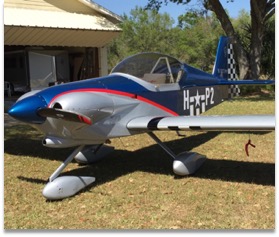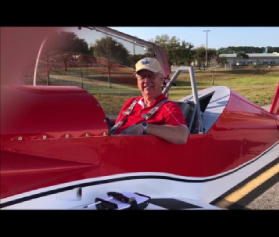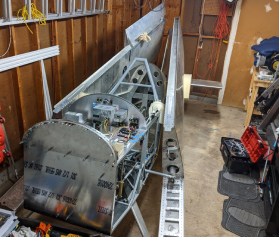Here is a synopsis of Bob’s flight per his words – Video link at the bottom –
“These are my first impressions of the Panther after an approximate 40 minute flight on April 23, 2013.
The location was at Haller Airpark, a turf runway at 1825 local time. Winds were light with a slight right quartering headwind with temperatures in the mid 70’s. The air was smooth above 2000 feet and most of the flight was conducted at altitudes between 2500 and 3500 feet AGL. Fuel load was 20 gallons.
I am 5 feet 8 inches and weigh 170 pounds. Dan Weseman is around 6 foot and 210 pounds. The necessary adjustments to accommodate my frame were made in about 2 minutes with an adjustment for sitting height. The multiple seat back adjustment made it easily compatible for my requirements. The quick rudder adjust feature only required a toe under the rudder pedals to relieve spring tension and slide the adjuster to the aft position. View and sitting position is very similar to my RV 4 and the sight picture is excellent. View out the front is excellent even with the canopy set to the taxi/open position for air flow.
This was my first experience flying behind a Corvair engine. Since most of my time has been behind big Lycomings, therefore some of the initial readings on RPM took a short time getting used to. Running the engine in the high 2000 RPM range and low 3000’s required mental adjustments. The engine response was smooth and RPM built quickly. The engine is extremely smooth and delivered excellent power during all phases of flight. Dan advised that he would like to see another 200 RPMs on the top end.
The takeoff acceleration was excellent and became airborne in about 600-700 feet. The grass surface was about 6 inches high and a slight amount of drag was noticed from the small 500×5 wheels. The tail tended to fly it self off to the proper attitude with very little forward stick and quickly accelerated to 90 MPH climbing at 1200 FPM. The RPM was about 3200 and during the climb, visibility was excellent. Initial control response was light and quick. A climb was complete to 3500 feet at 110 MPH maintaining around 1000 FPM.
A series of steep turns were completed with two 360 degree turns starting at 130 mph and ending at 80 mph. The elevator feedback through the turns was linear and remained light. Rudder impute was slightly sensitive and required minimal impute during the turns. These two controls were lighter than the RV and very responsive. The ailerons are very light with easy breakout pressures; with roll rate crisp up to one half aileron deflection. The Panther goes where you point it without hesitation.
A complete series of stalls were done; from no flaps to full flaps. The estimated airspeed for a clean stall will be somewhere in the mid forty range to low forty range for full flaps. The power out stalls show very little tendency to depart on a wing and only after holding the stall into a deep session did the left wing tend to drop with no flaps. During partial flap stalls the same results were noted as with no flaps. The full flap stalls were very gentle with no tendency to drop a wing as long as the ball was kept centered. A full aft stick stall was completed with a loss of 500 feet and the aircraft could be held in that condition with the rudder. A series of no flap 40 degree nose high 30 degree bank stalls were completed with no adverse reaction other than the aircraft had a tendency to nose drop and increase bank. This was easily controlled by a slight back pressure release and aileron and rudder to level the wings. Two vertical minimal power maneuvers were completed with max. Rudder deflection at 50 and 40 MPH. The first reacted with positive rudder with nose being pulled down to the vertical down line. The second resulted in the aircraft rolling over on its back and turning 270 degrees to arrive on the vertical down line. At no time did the aircraft exhibit a tendency to depart or inter a spin. All controls were positive during the low speed maneuver. The aircraft shows excellent spin resistance and positive stall recovery characteristics.
A full power level run was completed at 3000 feet AGL and max. Indicated airspeed was 165 mph at 3250 RPMs.
A full complement of aerobatic maneuvers was completed to include aileron rolls, barrel rolls, Cuban 8s, spit S, clover leafs, lazy 8s and loops. One series of loops was complete with a constant power set at 3000 RPMs entry speed of 140 and the second entry at 120. The G requirements were generally in the 2.5 area. Controls were effective throughout with no tendency for the aircraft to stall at the top of the loop at about 60 MPH indicated. Rudder and aileron effectiveness is strong with the elevator have good linear feel throughout all maneuvers. Compared to my RV 4 the rudder and elevator is about 30 % lighter. The rolling maneuvers using full aileron deflections showed easy breakout forces and a strong roll rate up to half to 70 % aileron deflection. After that point the aileron forces built to a little heavier than my RV 4 and the roll rate did not appear to increase significantly. I would estimate that with the LSA long wing the roll rate is about 60-70% of the roll rate of my RV 4. The tendency remained from 100 to 150 MPH during entry. Using rudder to assist in the roll rate did not appreciably increase the roll rate and resulted in a Dutch roll type tendency with the nose displacing opposite the roll rate. The roll rate is quite brisk and should be greater with the shorter sports wing model.
Descents into the pattern are quite easily controlled with power and the decent to pattern altitude was made at 160-170 mph. With the fix pitch prop the airplane slows from speed in a control manner and was configured for a normal landing. Landing fuel loads were about 16 gallons. The nose down deflection with full flaps is minimal and the trim system handles the loads and complete hands off trim could be completed. The base was flown at 70 mph with slowing to 62 mph on short final. The power was reduced to idle at 25 feet and the aircraft enter the flare at about 60 mph. The normal wheel landing was completed at the 300 foot point with a slight skip. The aircraft had no tendency toward over control and the landing roll was about 900 feet; no brakes were used. I felt that the final airspeed on final could be lower.
The Panther is a well-balanced airplane with light controls that goes where you point it with little effort.” – Bob Woolley – AKA “The Aggressor” and Panther Beta Builder – Sport Version, with a Lycoming O-320. see more here
YouTube Video Below



